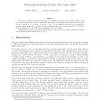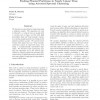CORR
2008
Springer
14 years 7 months ago
2008
Springer
We present a simple and efficient algorithm for randomly generating simple graphs without small cycles. These graphs can be used to design high performance Low-Density Parity-Chec...
CORR
2008
Springer
14 years 7 months ago
2008
Springer
We introduce a general stochastic model for the spread of rumours, and derive mean-field equations that describe the dynamics of the model on complex social networks (in particula...
CORR
2010
Springer
14 years 7 months ago
2010
Springer
We consider random walks on two classes of random graphs and explore the likely structure of the vacant set viz. the set of unvisited vertices. Let (t) be the subgraph induced by ...
ALGORITHMICA
2010
14 years 7 months ago
2010
We study the merging process when Kruskal's algorithm is run with random graphs as inputs. Our aim is to analyze this process when the underlying graph is the complete graph ...
ICML
2010
IEEE
14 years 8 months ago
2010
IEEE
We describe an algorithm for clustering using a similarity graph. The algorithm (a) runs in O(n log3 n + m log n) time on graphs with n vertices and m edges, and (b) with high pro...
IJCAI
2001
14 years 8 months ago
2001
We show that nodes of high degree tend to occur infrequently in random graphs but frequently in a wide variety of graphs associated with real world search problems. We then study ...
SODA
2008
ACM
14 years 8 months ago
2008
ACM
In the past decades the Gn,p model of random graphs, introduced by Erdos and R
APPROX
2008
Springer
14 years 9 months ago
2008
Springer
In order to perform an average-case analysis for specific input distributions one needs to derive and understand properties of a 'typical' input instance. In the case of...
LATIN
2000
Springer
14 years 11 months ago
2000
Springer
We look at the minimal size of a maximal matching in general, bipartite and
129
click to vote
SIGAL
1990
14 years 11 months ago
1990
We propose and analyse a quasirandom analogue to the classical push model for disseminating information in networks ("randomized rumor spreading"). In the classical mode...


